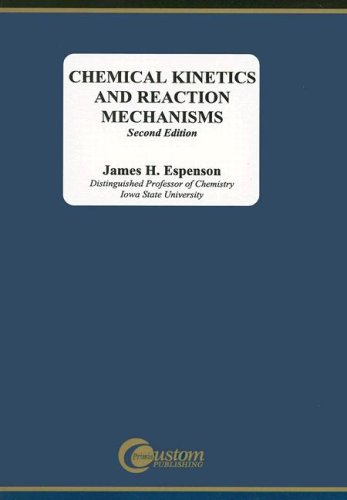Chemical kinetics and reaction mechanisms book
Par ramirez angela le vendredi, juin 3 2016, 02:22 - Lien permanent
Chemical kinetics and reaction mechanisms by James H. Espenson


Chemical kinetics and reaction mechanisms James H. Espenson ebook
Format: djvu
ISBN: 0070202605, 9780070202603
Publisher: McGraw-Hill Science/Engineering/Math
Page: 296
With nitrous acid, azo coupling reaction of diazonium salts of aromatic amines, Sandmeyer and related reactions of diazonium salts; carbylamine reaction; Haloarenes: nucleophilic aromatic substitution in haloarenes and substituted haloarenes (excluding Benzyne mechanism and Cine substitution). Download Chemical kinetics and reaction mechanisms. It begins by introducing chemical kinetics and the analysis of reaction mechanism, from basic. The value of structural information is greatly enhanced by classical protein chemistry and modern methods of site-directed mutagenesis (changing the amino acid sequence of a protein in a defined way by genetic engineering; see Chapter 28) that permit . The topic of chemical kinetics deals with the rate and mechanism of chemical reactions. Chemical kinetics and equilibrium. Chemical kinetics: Rates of chemical reactions; Order of reactions; Rate constant; First order reactions; Temperature dependence of rate constant (Arrhenius equation). Mechanisms and kinetics of chelating reaction between chitosan and Pd(II) in chemical plating pretreatment. � Besides information about the speed at which reactions occur, kinetics also sheds light on the reaction mechanism (exactly how the reaction occurs). Chemical kinetics and reaction mechanisms book download. Many enzymes that follow Michaelis-Menten kinetics have quite different reaction mechanisms, and enzymes that catalyze reactions with six or eight identifiable steps will often exhibit the same steady-state kinetic behavior. Abstract: Recent studies have shown that heterogeneous reactions of hydrogen peroxide (H2O2) on aerosol surfaces may play an important role in tropospheric chemistry. Rate constant of chemical reactions, temperature dependence, collision and transition state General characteristics of d and f block elements; Coordination chemistry; structure and isomerism; stability; theories of metal‐ligand bonding (CFT and LFT); mechanisms of substitution and electron transfer reactions of coordination complexes. Kinetics Kinetics‡ Studies the rate at which a chemical process occurs.